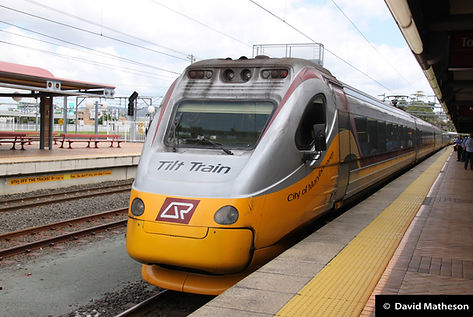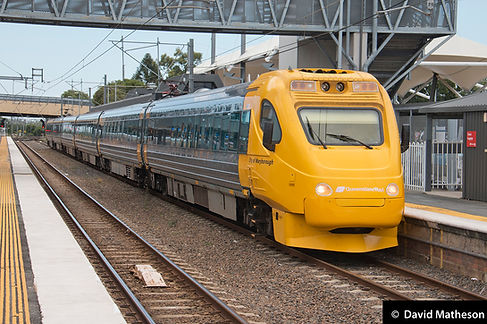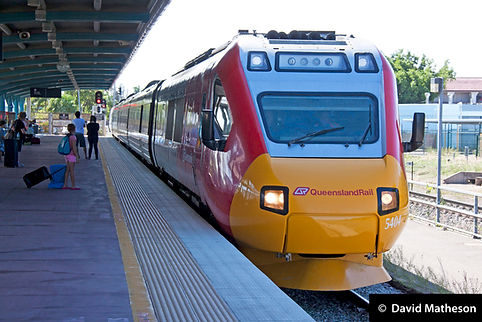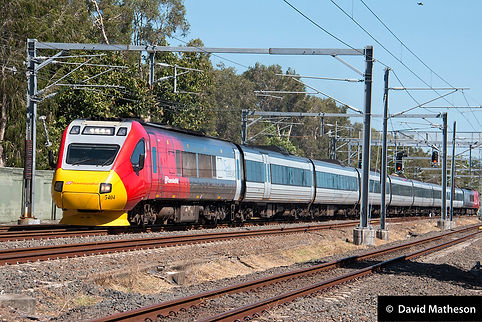Railways and Tramways of Australia


Electric Tilt Train, Roma Street station, Queensland, 27 September 2010.
Class leader TTD5301, City of Maryborough, at the front of the northbound electric Tilt Train, Caboolture, 14 January 2018.
Tilt Trains
David Matheson
7 September2025
Queensland Rail operates electric Tilt Trains between Brisbane and Rockhampton, the end of the electrified network. The Tilt Trains have a maximum speed in regular service of 160 km/h. Diesel Tilt Trains operate between Brisbane and Cairns, a distance of 1681 km.
Tilting trains
Tilting Trains are in service, or have been used, in a number of countries in the world, including Japan, Taiwan, the United Kingdom, Spain, Sweden and Germany. These trains feature a mechanism that tilts the train inwards when travelling around curves, which counteracts the centrifugal force that pushes outwards. This technology enables the train to move at a higher speed than non-tilting trains on the same track. The first Tilt Train was built in the United States in 1939.
Tilt train technology also reduces the capital cost of establishing high speed rail services by enabling trains to run faster on existing tracks with minimal upgrading. Sweden’s X2000, Italy’s Pendolino, and the United States’ Acela are tilting trains with maximum speeds of 200–250 km/h that operate on conventional railway lines. However, very high speed trains require the construction of dedicated lines that are separated from other networks.
Tilt trains may use passive or active tilting. Passive tilting is where the train is designed in a way that the forces of inertia cause the train to tilt. Active tilting involves mechanisms controlled by a computer forcing the tilt to occur.
New South Wales Trial
Three of Sweden’s X2000 carriages were trialled in New South Wales during 1995. The carriages were a driving trailer, a bistro carriage and a first class carriage. Two XPT power cars provided the motive power for the train while it was in New South Wales. It was generally restricted to a maximum of 160 km/h, although speeds of 170 km/h were recorded during controlled operating. The X2000 covered 95,000 km in New South Wales. This included a demonstration tour in March 1995 and 57 days in revenue service between Sydney and Canberra. The existing timetable of 4 hours, 7 minutes was reduced to 3 hours, 25 minutes. Before the X2000 could operate in New South Wales, some track slewing and cutting back of platform faces was required. The carriages returned to Sweden after the trial and the New South Wales Government did not proceed with procurement of Tilt Trains for the state.
Queensland Electric Tilt Trains
The Queensland Government gave approval to the first Tilt Train project for the state in February 1993. It included acquisition of two electric Tilt Trains of six carriages each, which would operate between Brisbane and Rockhampton, a distance of 639 km. As well as the design and manufacture of the trains themselves, a range of infrastructure upgrades were also required. Sharp curves and gradients were realigned to enable the trains to operate at speeds of up to 160 km/h. There were 30 deviations of the North Coast line completed, with a combined distance of around 80 km. Bridges that were understrength were either replaced or strengthened, and timber sleepers north of Caboolture were replaced with pre-stressed concrete sleepers. Signals and level crossings were upgraded to cater for higher train speeds.
Queensland’s Tilt Trains use both passive and active tilting. The carriages are mounted on rollers that are located on each of the bogies. Forces of inertia enable passive tilting to occur when the train travels around curves and return upright on straight sections of track. Active tilting involves the use of hydraulic rams, which pushes the carriage on the rollers, thus forcing the tilt. A database of the track profile that the train travels along is programmed into an onboard computer, which activates the tilt mechanism as the train approaches each curve. Track magnets also confirm the train’s position. The pantographs are designed to tilt in the opposite direction to the carriages.
The electric Tilt Trains were built by Walkers Limited at Maryborough in Queensland. Each set consists of six carriages:
-
44.0 t (TTD: driving motor car); 43.0 t (TTM: non-driving motor car); 47.0 t (TTR: trailer car)
-
Two driving motor car (TTD), one at each end
Two trailer cars (TTR), one next to each of the driving motor cars -
Two non-driving motor cars (TTM) in the middle of the train.
The length of the train is 136 metres and seating is provided for 310 passengers.
It had been planned that the Tilt Trains would commence service on 1 March 1997. However, delays in the design and manufacturing processes, and teething problems during trails, led to significant delays. Prior to their introduction to service, extensive testing of the new Tilt Trains was undertaken. Following testing the train was put on public display at Roma Street station on 1 November 1998. Queensland Rail Chief Executive, Vince O’Rourke, spoke to the large crowd. He then introduced the Queensland premier, Peter Beattie, and Minister for Transport, Steve Bredhauer, who cut a ribbon to launch the train. Mr Bredhauer noted that orders had been placed for diesel Tilt Trains that would operate as far as Cairns.
Over the following days both Tilt Trains travelled north on a promotional tour. Sets 303 and 304 made stops for public inspections at Nambour, Gympie North, Maryborough West and Bundaberg, then returned empty to Brisbane. During the stop at Maryborough West, Premier Beattie and Minister Bredhauher named them City of Maryborough. Sets 301 and 302 ran empty from Brisbane to Gladstone for a stop, and then continued to Rockhampton for the final stop of the tour.
On Friday 6 November the inaugural revenue run of the Tilt Trains was from Rockhampton to Brisbane. Sets 301 and 302 were named City of Rockhampton by Minister Bredhauher before departure. The train attracted considerable publicity before departure, during the journey, and upon arrival at Brisbane’s Roma Street station. It had become the first permanent Tilt Train service in Australia. Regular services commenced between Brisbane and Rockhampton. On 26 July 1999 a weekday service also began between Brisbane and Bundaberg, a distance of 351 km.
There are eight services of the electric Tilt Train between Brisbane and Rockhampton each week, with seven between Rockhampton and Brisbane. Additionally, four services commence at Brisbane and terminate at Bundaberg each week, while five services commence at Bundaberg and terminate at Brisbane. Travel time between Brisbane and Rockhampton is eight hours and five minutes in both directions. Between Brisbane and Bundaberg the travel time is four hours and 40 minutes in both directions.
The Australian railway speed record of 210 km/h was set by a Queensland Rail Electric Tilt Train during a non-passenger run on 23 May 1999. It reached this speed between Meadowvale and Avondale, north of Bundaberg, on a lengthy section of straight track. The train’s speed was monitored by on-board and trackside measuring devices, and was verified by police using radar speed measuring equipment. This is also the record for the fastest narrow gauge train in the world.
Queensland Diesel Tilt Trains
The Queensland Government committed to construction of diesel Tilt Trains in 1998 to operate between Brisbane and Cairns. Orders were placed for two trains, which would each include two power cars, one at each end of the train, and seven passenger cars. Original plans for sleeping accommodation were dropped as this would have meant the budget for the project could not be sustained. Like the earlier electric Tilt Trains, the diesel Tilt Trains were designed by Walkers Limited at Maryborough in Queensland. Before construction was completed, Walkers had been sold to Evans Deakin Industries (EDI), who completed the project.
Extensive testing of both trains was undertaken between January and June 2003 along the complete length of the line between Brisbane and Cairns, a distance of 1681 km. Drivers and maintenance staff were trained, and a timetable for the train was developed. On 15 June the two trains were officially handed over to Queensland Railways.
Each Diesel Tilt Train set has the following carriages:
-
Two power cars (DTD)
-
One luggage/crew car (DTB)
-
Three sitting cars (DTL)
-
One dining/lounge car (DTC)
-
Two sitting cars with access for people with disabilities (DTP).
The power cars each have two MTU 12V396 engines, which provides traction power of 2700 kW, and have a mass of 60.0 tonnes. Although the power cars are not fitted with tilting mechanisms because of space limitations, bogies with excellent riding quality have been included. The trailer cars are built to the same basic design as those on the electric Tilt Trains.
Following an official launch on 15 June 2003, the first public service departed from Brisbane’s Roma Street station for Cairns on the evening of 16 June.
Spirit of Queensland
On 27 October 2010 Queensland Premier Anna Bligh announced that a new diesel Tilt Train set would be purchased and that the existing two sets would be upgraded. The new train commenced service on 28 October 2013 with the name Spirit of Queensland.
Passengers travelling on the Spirit of Queensland have the option of booking a Premium Economy seat or a Railbed. A Railbed is a seat that can be converted to a bed at night time, and this style of accommodation includes linen and a pillow, while meals are delivered to the passenger’s seat. Premium Economy has 2 + 2 seating whereas the railbed carriages have a 2 + 1 layout. Both categories of travel include an entertainment screen. Showers and toilets are provided at the end of each carriage.
The Sunlander was a locomotive-hauled train that operated between Brisbane and Cairns from 1953. Upon introduction of the diesel Tilt Train, The Sunlander continued to operate. Passengers had a choice between The Sunlander, which was slower but had cheaper fares, or the diesel Tilt Train, which was faster but more expensive. The Sunlander also provided traditional sleeping carriages with separate compartments, as well as a motorail service, which was not available on the Spirit of Queensland. Following the upgrade of the two diesel Tilt Train sets, The Sunlander was withdrawn from service. Its last northbound run departed from Roma Street station in Brisbane on 28 December 2014, and the last southbound service departed from Cairns on 31 December, arriving at Roma Street on 1 January 2015.
The Spirit of Queensland runs between Brisbane and Cairns four times a week in each direction. The journey is 25 hours and 20 minutes in duration for both northbound and southbound travel.
Accidents
One of the diesel Tilt Trains was derailed near Berandjo, located approximately 74 km north of Bundaberg, on 15 November 2015. Twelve passengers received serious injuries and others sustained moderate injuries. The leading power car, DTD5403, turned over on its side, Car A derailed but remained upright, Cars B to D jack-knifed and finished almost side by side, Car E tipped on its side, Car F remained upright but turned almost 90 degrees to the track, while the trailing power car was derailed but remained upright.
The principal cause of the derailment was found to be excessive speed. The train was travelling at 112 km/h as it entered a curve that has a speed limit of 60 km/h. There was extensive damage to the leading power car and the carriages. Three overhead traction support poles were destroyed, along with overhead wiring. Around 120 metres of track, sleepers and ballast were damaged, requiring replacement. A temporary speed limit of 100 km/h was placed on all Tilt Train services.
A second serious accident occurred on 27 November 2008 when the northbound diesel Tilt Train collided with a loaded B-double truck at the Rungoo level crossing, around 20 km north of Ingham, between Townsville and Cairns. The two drivers on board the train were killed as a result of the collision, while nine passengers received injuries. The truck driver suffered moderate injuries.
The B-double truck was travelling at an estimated speed of 75 km/h at the time of impact, while the train was travelling at 57 km/h, both speeds under the maximum permitted limits. The truck driver said that he did not see the advance warning signs and road markings advising that it was approaching the level crossing. He said that he saw the flashing light signal assemblies but the lights themselves were not working. Two people in a vehicle following the truck said that they had seen the lights flashing.
The lead power car (DTD 5403) was severely damaged, particularly in the driver’s vestibule and cabin. DTD 5403 was the same lead power car that was involved in the level crossing collision near Berandjo in 2005. It was scrapped following the accident in 2008.
References
Australian Transport Safety Bureau, Derailment of Cairns Tilt Train VCQ5, Canberra, 2005.
Australian Transport Safety Bureau, Fatal Collision between the Cairns Tilt Train and B-Double Truck, Canberra, 2009.
Ferrandiere, E, Hoyle, J, & Shale, S, ‘QR diesel tilt train derailment report, Railway Digest, vol. 43, no. 1, January 2005, pp. 4–5.
Foldi, D, ‘Leaning towards the future…Countrylink’s X2000 Tilt train trial’, Permanent Way Institution (PWI) NSW, 1995 Annual Convention:
Tunnelling, Tracking, Tilting, Titillating, 13 October 1995.
Hoyle, J, ‘Australia enters the Tilt train era’, Railway Digest, vol. 36, no. 12, December 1998, pp. 22–5, 40.
Hoyle, J, ‘QR’s Diesel Tilt Train: a technical ‘snapshot’’, Railway Digest, vol. 41, no. 8, August 2003, pp. 17–20.
Hoyle, ‘Spirit of Queensland tilt train service commences’, Railway Digest, vol. 51, no. 12, December 2013, p. 16.
Hoyle, J, ‘Sunlander bows out in style’, Railway Digest, vol. 53, no. 2, February 2014, pp. 14–15.
Hunter, R, ‘Tilt trains: the Queensland experience’, CORE 2000, Railway Technology for the 21st Century, Conference on Railway Engineering, Glenelg, South Australia, 21–23 May, 2000.
Jirasek, J, & Smart, C, ‘Cairns Tilt Train alliance project: a success story of technical and commercial innovation’, Conference on Railway
Engineering, Wollongong, 10-13 November 2002.
Michell, M, Martin, S & Laird, P, ‘Building a railway for the 21st century: bringing high speed rail a step closer’, Conference on Railway Excellence,
Proceedings, Railway Technical Society of Australasia, 2014, pp. 612-621.
‘Tilting train’, Wikipedia, <https://en.wikipedia.org/wiki/Tilting_train>.
‘Two journeys on the Cairns Tilt Train’, Railway Digest, vol. 41, no. 9, September 2003, pp. 21–5.
‘Walkers/Hitachi Electric Tilt Train (300 series)’, Queensland’s Railway Interest Group <http://www.qrig.org/motive-power/self-propelled-passenger-
stock/electric-multiple-units/walkershitachi-electric-tilt-train-300-series>.

Southbound diesel Tilt train arriving Townsville station, 2 January 2013.

DTD5404 leading Brisbane-bound diesel Tilt Train approaching Northgate in the northern suburbs of Brisbane, 15 January 2018.